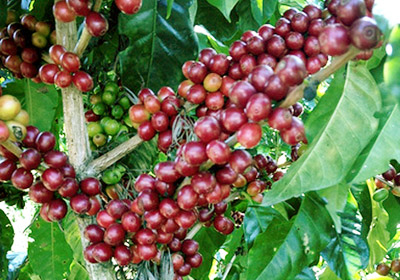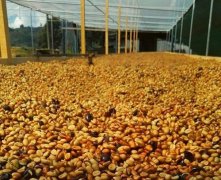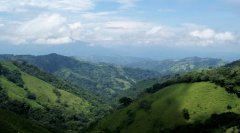How do you make Costa Rican coffee? Costa Rican coffee bean grading standard tells you

Professional barista communication, please pay attention to coffee workshop (Weixin Official Accounts cafe_style)
Costa Rican coffee was introduced from Cuba in 1779. Costa Rican coffee is produced almost exclusively in the high-altitude mountains surrounding San Jose. This large region is divided into four main producing areas, Tarrazu, Tres Rios, Heredia and Alajuela. With all the conditions necessary to grow good coffee, expensive and rare soil properties, volcanic and alpine climate, it is clear that this mountain area provides the most magnificent growing environment for Costa Rican coffee beans.
Costa Rican coffee beans are graded on the basis of their hardness, unlike Kenyan coffee beans, which are graded on the basis of size. The altitude of the plantation determines the hardness of the coffee beans. In Costa Rica's coffee grading system, a coffee bean labeled SHB is grown at an altitude of more than 3900 feet (1188 meters). Coffee beans labeled GHB are grown at heights ranging from 3300 to 3900 feet (1,005 - 1,188 meters). Coffee beans labeled MHB grow at altitudes between 1600 and 3300 feet (487- 1,105 meters). Most Costa Rican coffee is grown near the Atlantic Ocean, so there is a popular saying in Europe that "high-ripeness Costa Rican coffee is in the Atlantic Ocean", which is deeply affirmed and supported by Europe.
Unlike most other specialty coffees, specialty coffee beans from Costa Rica are often traded directly with coffee plantations. Costa Rica actually has more than 150,000 coffee farms and plantations large and small, and La Minita was the most popular Costa Rican representative in the early days. Most small farms will cluster and identify as cooperative organizations, only larger farms will operate independently.
Costa Rican coffee varieties are dominated by new species Caturra, Catuai, which have recently appeared in natural variation in 1935. Harvest begins in October and spans the year until March. Bright, clean, and slow are the hallmarks of Costa Rican coffee. The palate is soft and balanced, citrus and berry blended in mild acidity, chocolate or spice-like notes emerging in the back palate.
In order to improve the quality of coffee and to enhance the economic value of crops, the government of Costa Rica in the early 20th century through the law clearly stipulated that coffee farms or plantations belonging to Costa Rica can only grow Arabica beans, that is, coffee produced in Costa Rica can never appear Robusta trace, because this regulation makes Costa Rica coffee beans and all coffee producing countries to make a clear distinction, in the international market is also more competitive strength.
Of all Central American coffees, Costa Rican coffee is the strongest and most suitable for blending with other coffee beans. Some non-gourmet coffee beans or smaller grades of Costa Rican coffee beans are often blended and sold, and it is often found in commercial blends.
Important Notice :
前街咖啡 FrontStreet Coffee has moved to new addredd:
FrontStreet Coffee Address: 315,Donghua East Road,GuangZhou
Tel:020 38364473
- Prev

The Secret of Costa Rican Honey processing Coffee Color-suggestion of Costa Rican Coffee hand-flushing parameters
For the exchange of professional baristas, please follow the coffee workshop (Wechat official account cafe_style) Costa Rica is one of the familiar coffee producing areas, and you must often see beans like the XX manor / processing plant honey treatment in Costa Rica. Speaking of which, someone may raise his hand and say, "teacher, I know!" Honey treatment is the beans treated with honey! Well, actually, a lot of people
- Next

Introduction to Costa Rica Coffee Manor in Costa Rica-Tarrazu three Wonders Manor in Tarazu
Exchange of professional baristas Please pay attention to the Coffee Workshop (Wechat official account cafe_style) the rich volcanic ash, mild and suitable temperature, and stable and abundant rainfall in Costa Rica are one of the factors that make coffee a major agricultural product in Costa Rica. Its coffee beans are all Arabica species. Pure flavor, pleasant aroma, both in acidity and taste
Related
- Detailed explanation of Jadeite planting Land in Panamanian Jadeite Manor introduction to the grading system of Jadeite competitive bidding, Red bid, Green bid and Rose Summer
- Story of Coffee planting in Brenka region of Costa Rica Stonehenge Manor anaerobic heavy honey treatment of flavor mouth
- What's on the barrel of Blue Mountain Coffee beans?
- Can American coffee also pull flowers? How to use hot American style to pull out a good-looking pattern?
- Can you make a cold extract with coffee beans? What is the right proportion for cold-extracted coffee formula?
- Indonesian PWN Gold Mandrine Coffee Origin Features Flavor How to Chong? Mandolin coffee is American.
- A brief introduction to the flavor characteristics of Brazilian yellow bourbon coffee beans
- What is the effect of different water quality on the flavor of cold-extracted coffee? What kind of water is best for brewing coffee?
- Why do you think of Rose Summer whenever you mention Panamanian coffee?
- Introduction to the characteristics of authentic blue mountain coffee bean producing areas? What is the CIB Coffee Authority in Jamaica?

